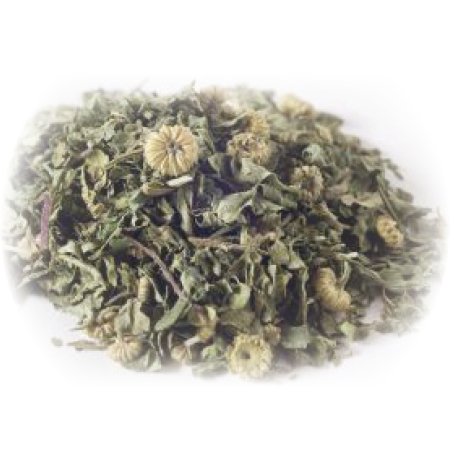Feverfew (Tanacetum parthenium) – Dried Herb, Organic
$19.17 – $191.70
Feverfew is an herbaceous perennial in the Asteraceae family also called Compositae family, Aster family or Daisy family with 1,620 genera and 600 species of herbs, trees and shrubs around the word– making it is one of the largest plant families. Feverfew has small white flowers – that look similar to Chamomile – and pinnate leaves, and blossoms from July to October.
Feverfew is native to the Balkan Peninsula and is now naturalized in Australia, Europe, China, Japan and North Africa. Feverfew is known by other names, including Bachelor Button, Camomille Grande, Chrysanthemum Parthenium, Featherfew, Featherfoil, Flirtwort Midsummer Daisy and Santa Maria.
Feverfew has a long history of use in traditional European herbalism. The herb is typically tinctured, steeped as tea or employed topically. The early Romans believed in its medicinal use of the flowers as a cosmetic wash. In ancient Greece, Dioscorides often used it to support labour and in the delivery of the placenta if contractions were not regular. It was thought that drinking the tea would strengthen the womb. Ancient Greek physicians used it to reduce inflammation and treat menstrual cramps.
This herb has been used for centuries as a traditional medicine for colds, fevers, migraines and pain associated with muscles and joints. Eclectic physicians used Feverfew as a gastrointestinal tonic, to improve digestion and to increase hunger. Other historical uses of Feverfew include nervous afflictions, pain due to poor circulation, earache, trauma and intestinal parasites. As well, the plant was applied topically to treat insect bites and its oil was applied to painful joints and muscles.
Properties:
The taste and energetics of Feverfew are bitter, acrid, cooling, stimulating and astringent. Feverfew has an affinity towards the musculoskeletal system, circulatory system, uterus, brain, digestive system, immune system, respiratory system and skin. Combine Feverfew with Yarrow, Boneset or Anise Seed to support the immune system. For possible prevention of certain migraines combine Feverfew with Wood Betony, Willow Bark or Valerian Root.
How to use:
1 teaspoon of Feverfew to one cup of boiling water. Infuse for 15 minutes, strain and drink up to three cups.
Cautions & contraindications:
Feverfew is contraindicated in patients allergic to other members of the Asteraceae family, such as Aster, Chamomile, Chrysanthemum, Ragweed, Sunflower, Tansy and Yarrow. Due to its potential antiplatelet effects, it is not recommended for use in patients undergoing surgery.
This information is for educational purposes only and is not intended to diagnose, treat or cure any disease or illness. Please consult your healthcare provider prior to the use of this product if you are pregnant, nursing, taking medications or have a medical condition. Individual results may vary.


Reviews
There are no reviews yet.